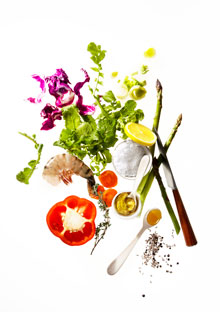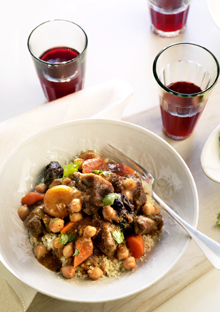
Photo: Gentl & Hyers
Anyone can follow a recipe. But what about those talented people who can take whatever's on hand, throw in a pinch of this, a dash of that, and come up with something delicious—and different? Here's a simple method for cutting yourself loose from cookbooks and having more fun in the kitchen.
Picture yourself as a happy cook doing what you love best: preparing a great dinner. You are not anxiously scrutinizing your cookbook every few seconds to make sure you're following the instructions to the letter. Nor are you robotically generating dishes you've made so many times you could churn them out in your sleep. Instead, you're engaged in a kind of improvisational dance—smelling, stirring, tasting, adjusting. All your senses are fully engaged.Get inspired by the recipes we came up with using these techniques
If you aspire to be a more skillful cook, there are thousands of sources you can turn to for recipes and technical advice. But if you want to be a more intuitive cook—the kind who can whip up a delicious dinner from the seemingly incongruous ingredients on hand or know instantly that the soup needs a jolt of lemon—there are ways you can learn to trust your own imagination and taste. Instead of following recipes, you can shrug off your inhibitions.
Start by experimenting. If you're a creature of habit who turns to the same seasonings every time you prepare a particular food—roast chicken, say, or grilled asparagus—try changing one ingredient. Replace rosemary with thyme, or olive oil with hazelnut oil. Your goal is just to begin tasting, smelling, paying attention—and to observe what happens when certain flavors collide.
Okay, but let's say you don't even know where to begin guessing what flavors might work well together. Don't despair. For help and inspiration, we turned to Karen Page and Andrew Dornenburg, authors of The Flavor Bible, an innovative guide to the many different ways you can combine ingredients without resorting to recipes. They've compiled a list of 600-plus food entries, arranged alphabetically (from achiote seeds to zucchini blossoms). Underneath each food, they've included a list of complementary ingredients, or "flavor affinities," that pair well with it—from herbs and spices to nuts and meats. Page and Dornenburg begin by explaining the basic principles of balancing tastes like salty, sweet, bitter, and sour. But mainly, they encourage you to experiment.
The key is to build on what you already know—and like. If you've roasted pork chops with apples before—a classic combination that marries the richness and slight astringency of the pork with the sweetness of the fruit—you may decide to grill or roast the chops with a different fruit (like peaches), and drizzle some balsamic vinegar on top. You might discover this combination in the book, which lists peaches and balsamic vinegar as flavor affinities for pork chops—or you might eventually come up with it by intuition, or by finding it on a restaurant menu.

Photo: Gentl & Hyers
Another strategy is to repurpose ingredient combinations that are already familiar to you—asparagus with Fontina cheese and ham, for example. Instead of serving them the same way you always do (in a salad, perhaps), use those ingredients to make a sandwich or a pasta sauce (sauté the asparagus with diced ham, then grate the Fontina over the hot pasta at the last second).
Researching the book, says Page—a lifelong food scholar and Harvard MBA—meant excavating information that existed only "in the heads of chefs."
"Our goal was to collect it, synthesize it, and put it out there in a form that people can access," she says. Adds Dornenburg, coauthor (with Page) of six previous food books, including Culinary Artistry and What to Drink with What You Eat—and a former chef at Biba in Boston: "Almost every dish I've been cooking my whole life, I now have new ideas for."
To illustrate how flavor affinities can evolve into actual dishes, we started with several familiar, versatile ingredients (shrimp, potatoes, asparagus, lamb, pork) and created recipes around them, using suggested pairings from The Flavor Bible. Whether you prefer to follow these recipes or just use them to jump-start your own culinary forays, remember the first principle of creative cooking: Pay more attention to the flavors than to the instructions. And be ready to make adjustments—for instance, adding extra sugar if a fruit called for is not in season.
With practice, you'll learn to trust your senses as much as, if not more than, a recipe in a book. Before long, you'll find that the culinary authority you turn to most often for ideas and inspiration is...yourself.
Researching the book, says Page—a lifelong food scholar and Harvard MBA—meant excavating information that existed only "in the heads of chefs."
"Our goal was to collect it, synthesize it, and put it out there in a form that people can access," she says. Adds Dornenburg, coauthor (with Page) of six previous food books, including Culinary Artistry and What to Drink with What You Eat—and a former chef at Biba in Boston: "Almost every dish I've been cooking my whole life, I now have new ideas for."
To illustrate how flavor affinities can evolve into actual dishes, we started with several familiar, versatile ingredients (shrimp, potatoes, asparagus, lamb, pork) and created recipes around them, using suggested pairings from The Flavor Bible. Whether you prefer to follow these recipes or just use them to jump-start your own culinary forays, remember the first principle of creative cooking: Pay more attention to the flavors than to the instructions. And be ready to make adjustments—for instance, adding extra sugar if a fruit called for is not in season.
With practice, you'll learn to trust your senses as much as, if not more than, a recipe in a book. Before long, you'll find that the culinary authority you turn to most often for ideas and inspiration is...yourself.
The first principle of intuitive cooking: Pay more attention to flavors than instructions. Start with a favorite food (shrimp?), experiment by tweaking a tried-and-true recipe with new ingredients, and observe what happens when flavors intersect.
PorkThis meat is a staple of diets worldwide, so it's no wonder there are thousands of recipes for it—from Sichuan dumplings flavored with ginger, sesame, and soy sauce to Mexican posole stews made with cumin, oregano, and chipotle peppers. Pork has a slightly astringent taste that pairs well with the sweet-tart flavors of barbecue sauce—as in our recipe below.
Recipe: Barbecue Pork Chops with Red Cabbage Slaw
Shrimp
Slightly sweet with a mild brininess, shrimp makes a lovely match for a wide range of ingredients. Salty bacon is a classic counterpart, as is spicy cocktail sauce. In our recipe for Arugula Salad with Honey-Glazed, Bacon-Wrapped Shrimp, the vinaigrette-dressed greens provide a satisfying tang that plays off the richness of the bacon.
Recipe: Arugula Salad with Honey-Glazed, Bacon-Wrapped Shrimp
Potatoes
Because of the many guises they can assume, potatoes are often thought of as meek, adaptable sidekicks. But while they make a terrific complement to big-flavored meats and fish, they have a distinct, earthy flavor all their own and can play a starring role. For instance, you can turn them into crunchy hash browns, and throw in leeks and red peppers, whose sweet flavors stand out well against the potato taste.
Recipe: Hash Browns with Leeks and Bell Peppers
Asparagus
Asparagus has a pleasantly sharp flavor that balances nicely with the richer taste and texture of ingredients like cheese, ham, and egg-yolk-based sauces such as hollandaise. We've created a roasted asparagus salad with goat cheese and toasted bread crumbs to highlight that contrast, and used lemon zest and sea salt for added zing.
Recipe: Roasted Asparagus Salad with Goat Cheese and Bread Crumbs
Lamb
This meat's inherent richness makes it wonderfully versatile, with a strong taste that can handle a wide variety of herbs, spices, vegetables, grains, and other accompaniments. If you usually roast lamb with garlic and rosemary, start by substituting an herb like lavender, savory, or thyme for the rosemary. And because the gaminess of the meat finds a counterpoint in sweet flavors, it works perfectly in a Moroccan lamb stew made with prunes and apricots.
Recipe: Moroccan Lamb Stew with Chickpeas and Prunes




